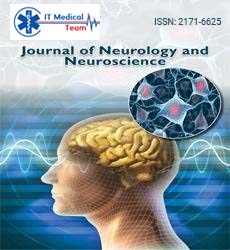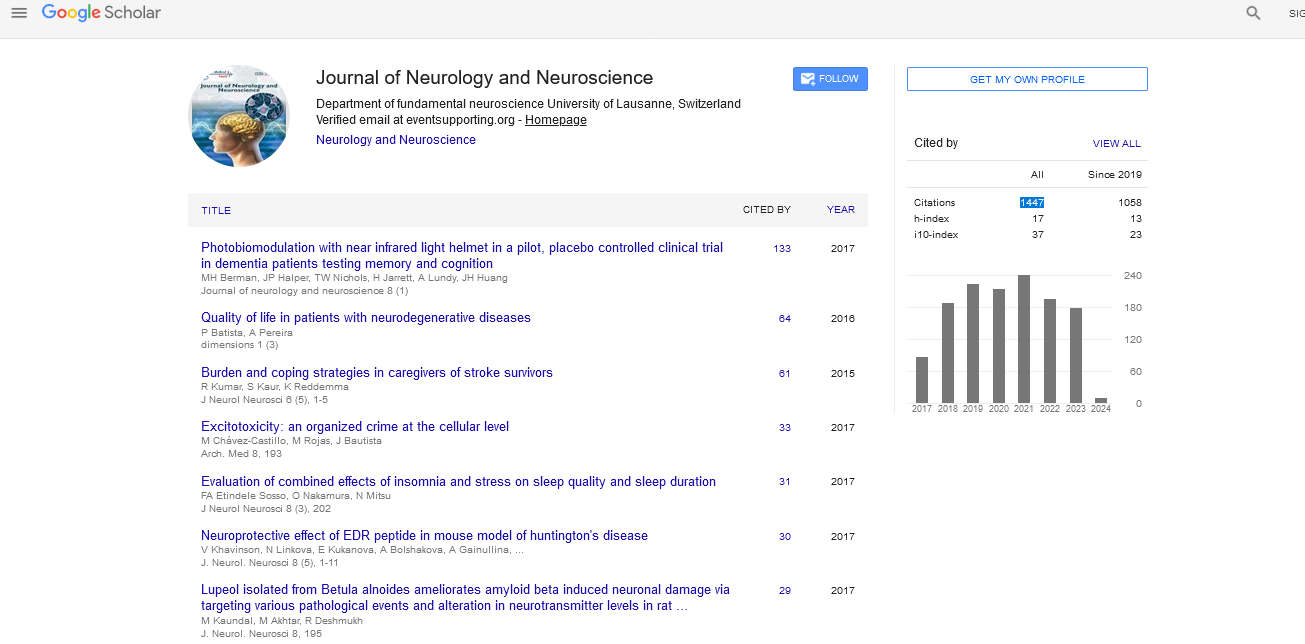Perspective - (2024) Volume 15, Issue 6
Cutting-edge neuroanatomical mapping tools for today’s neuroscientists
Elisa Zeka*
1Department of Pediatrics, Washington University School of Medicine,St. Louis, MO 63110, United States
*Correspondence:
Elisa Zeka, Department of Pediatrics, Washington University School of Medicine,St. Louis, MO 63110,
United States,
Email:
Received: 27-Nov-2024, Manuscript No. ipjnn-25-15489;
Editor assigned: 29-Nov-2024, Pre QC No. P- 15489;
Reviewed: 13-Dec-2024, QC No. Q-15489;
Revised: 18-Dec-2024, Manuscript No. R-15489;
Published:
25-Dec-2024
Abstract
Rapid technological developments combined with a growing understanding of the structure and function of the brain are driving a remarkable evolution in the area of neuroscience. Neuroanatomical mapping techniques have seen some of the biggest advancements in recent years. These developments not only deepen our knowledge of the structure of the brain but also increase the accuracy of neurological research and clinical procedures. The most recent developments in neuroanatomical mapping methods are examined in this article along with their uses and consequences for contemporary neuroscience. The methods used to visualize and comprehend how the nervous system is organized are referred to as neuroanatomical mapping. A fuller comprehension of the interactions between various brain regions is made possible by mapping, which helps identify the regions in charge of particular functions
INTRODUCTION
Rapid technological developments combined with a
growing understanding of the structure and function of the brain
are driving a remarkable evolution in the area of neuroscience.
Neuroanatomical mapping techniques have seen some of the
biggest advancements in recent years. These developments not
only deepen our knowledge of the structure of the brain but
also increase the accuracy of neurological research and clinical
procedures. The most recent developments in neuroanatomical
mapping methods are examined in this article along with their
uses and consequences for contemporary neuroscience. The
methods used to visualize and comprehend how the nervous
system is organized are referred to as neuroanatomical
mapping. A fuller comprehension of the interactions between
various brain regions is made possible by mapping, which
helps identify the regions in charge of particular functions. [1].
In the past, conventional methods including histology,
MRI, and PET scans were used for neuroanatomical mapping.
Although these techniques yielded insightful results, their
resolution, specificity, and dynamic observation were limited.
For example, histological methods are damaging and give
a static picture of the structure of the brain, despite being
great for in-depth cellular investigation. In a similar vein,
albeit non-invasive, MRI and PET scans frequently lack the
spatial resolution required to identify finer anatomical details.
The launch of 7 Tesla (7T) MRI scanners is among the most
significant developments in imaging technology. The 7T MRI
offers much higher quality images than conventional 1.5T or
3T scanners, making it possible to see finer anatomical details
and smaller structures inside the brain. This advancement is
crucial for identifying subtle changes in brain anatomy that
may be associated with neurological disorders. Diffusion
Tensor Imaging is an advanced form of MRI that maps the
diffusion of water molecules in brain tissue
DESCRIPTION
Researchers can now see the microstructure of the brain
in three dimensions thanks to the novel SBFSEM technology.
SBFSEM offers an unmatched perspective of cellular
architecture by imaging individual slices of the brain after it
has been cut into thin parts. This approach is very useful for
researching how brain circuits are organized and how neurons
are connected. The CLARITY approach preserves the molecular
makeup of brain tissue while making it transparent. This helps
scientists better comprehend the interactions between various
brain regions by enabling them to see intricate neuronal
networks in intact tissue. There are also new transparency
techniques like iDISCO that provide high-resolution brain
circuit imaging without requiring a lot of sectioning [3].
Data analysis is being revolutionized by the incorporation
15 (06) 2024 : 001-002 â?¢ Perspective
2 â??
© J Neurol Neurosci
1. Yuval-Greenberg S, Tomer O, Keren AS, et al. Transient induced
gamma-band response in EEG as a manifestation of miniature
saccades. Neuron. 2008; 58(3):429-41.
2. Oldfield RC. The assessment and analysis of handedness: The
Edinburgh inventory. Neuropsychologia. 1971; 9(1):97-113.
3. Zheng P, Zeng B, Zhou C, et al. Gut microbiome remodeling
induces depressive-like behaviors through a pathway mediated by
the hostâ??s metabolism. Mol psychiatry. 2016; 21(6):786-96.
4. Tang N. Exosomes in multiple sclerosis and Alzheimer's diseaseâ??
Adversary and ally. Biomed J. 2024; 47(5):100665.
5. Zott B, Konnerth A. Impairments of glutamatergic synaptic
transmission in Alzheimerâ??s disease. Semin Cell Dev Biol 2023; 139:
24-34.
of Artificial Intelligence (AI) and Machine Learning (ML) into
neuroanatomical mapping technologies. Large volumes of
imaging data can be processed thanks to these technologies,
which improves the precision and speed of neuroanatomical
research. The time and potential biases involved in manual
analysis can be decreased by using automated segmentation
algorithms to recognize and distinguish between various brain
areas in imaging data. In large-scale investigations where
consistency and dependability are crucial, these methods
are especially helpful. Predictive modeling powered by AI
can assist in locating structural patterns in the brain that are
associated with particular behavioral outcomes or illness
conditions. This skill improves our comprehension of the
connection between brain structure and function by offering
hitherto unachievable insights [4].
Researchers are sharing their neuroanatomical data and
discoveries as a result of the growing popularity of open
data initiatives in neuroscience. This cooperative method
promotes creativity, speeds up research, and improves study
reproducibility. Researchers' and clinicians' visualization and
interaction with neuroanatomical data is being revolutionized
by the introduction of Virtual Reality (VR) and Augmented
Reality (AR) technology. By allowing researchers to examine
complex datasets in three dimensions, Virtual Reality (VR)
facilitates immersive examination of brain structures. This
capacity makes it easier to analyze complex neuroanatomical
relationships and improves spatial knowledge. During
operations, AR can superimpose neuroanatomical data onto the
surgeon's field of vision, improving surgical safety and accuracy.
Additionally, neuroanatomy is being taught in classrooms using
augmented reality (AR) technology, which offer interactive
experiences that enhance comprehension. MRI, PET, and
electrophysiological data are examples of imaging modalities
that can be combined to provide a more thorough understanding
of brain function. By identifying relationships between brain
activity, connectivity, and structure, multimodal techniques can
improve our comprehension of intricate neurological processes.
The use of AI technologies in neuroanatomical mapping will
develop more as these technologies progress. Personalized
medicine, predictive modeling, and image analysis algorithms
will improve our ability to comprehend neuroanatomical data.
Future developments will probably concentrate on creating
more patient-centric technologies that allow for customized
treatment regimens based on unique neuroanatomical profiles.
This strategy may result in notable progress in neurological
precision medicine [5].
CONCLUSION
The development of neuroanatomical mapping techniques
is a major advancement in contemporary neuroscience. These
developments have the potential to revolutionize clinical
practice and research approaches in addition to improving our
understanding of the anatomy and function of the brain. The
potential for deciphering the intricacies of the brain is endless
as long as technology keep developing. Our knowledge of the
nervous system will surely grow as a result of the combination
of high-resolution imaging, sophisticated histology methods,
machine learning, and immersive technology. Adopting these
developments is crucial for the modern neuroscientist who
wants to advance knowledge and enhance the lives of people
with neurological illnesses.
REFERENCES
- Yuval-Greenberg S, Tomer O, Keren AS, et al. Transient induced gamma-band response in EEG as a manifestation of miniature saccades. Neuron. 2008; 58(3):429-41.
Google Scholar, Crossref, Indexed at
- Oldfield RC. The assessment and analysis of handedness: The Edinburgh inventory. Neuropsychologia. 1971; 9(1):97-113.
Google Scholar, Crossref, Indexed at





